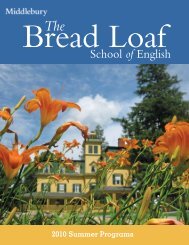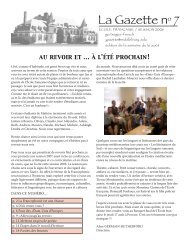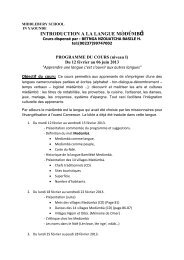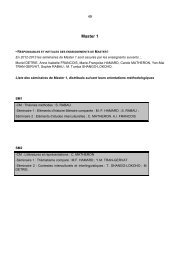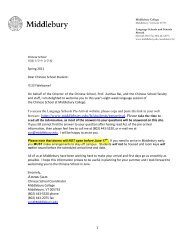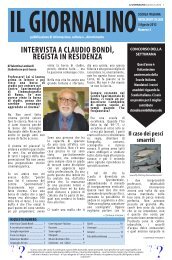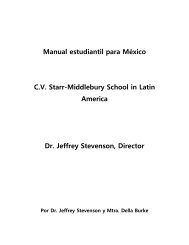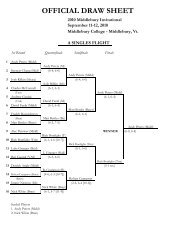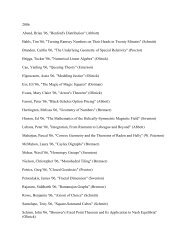2012 Summer Symposium Program - Middlebury College
2012 Summer Symposium Program - Middlebury College
2012 Summer Symposium Program - Middlebury College
You also want an ePaper? Increase the reach of your titles
YUMPU automatically turns print PDFs into web optimized ePapers that Google loves.
Page 20<br />
23<br />
Avery Shawler ‘13<br />
Major: ENVS, BIOL<br />
Bob Churchill Fund<br />
Bill Hegman<br />
GIS Specialist<br />
24<br />
Annika Silverman ‘13<br />
Major: ENVS, GEOL<br />
Gretchen Augat Reilly ‘60<br />
Environmental Studies Fund<br />
Peter Ryan<br />
Professor of Geology<br />
<strong>Middlebury</strong> <strong>Summer</strong> Research <strong>Symposium</strong> <strong>2012</strong><br />
Mapping Natural Communities for the Nature<br />
Conservancy/ Vermont Natural Heritage<br />
<strong>Program</strong><br />
Avery Shawler and Bill Hegman<br />
Department of Geography, <strong>Middlebury</strong> <strong>College</strong>, <strong>Middlebury</strong> VT 05753<br />
This summer I’m mapping natural communities for the Vermont Natural Heritage<br />
<strong>Program</strong>. A natural community is an interacting assemblage of organisms, their<br />
physical environment, and the natural processes that affect them. Identifying<br />
natural communities helps ecologists understand how species interact with each<br />
other and their physical environment. Classifying natural communities is important<br />
for conservation, land management and land use planning. The Vermont Natural<br />
Heritage <strong>Program</strong> has been working on mapping natural communities owned by<br />
The Nature Conservancy. I’ve just finished mapping the High Pond Preserve in<br />
Brandon, VT. Using a preliminary map created by Eric Sorenson, his field notes and<br />
aerial photography I’ve been creating a final map. I’ve worked in the field identifying<br />
species and natural communities and also in the GIS lab mapping out the natural<br />
communities. The next site that I’m mapping is the LaPlatte River delta.<br />
The Effect of Metamorphic Grade on Arsenic in<br />
Bedrock and Groundwater: An Analysis of Shales,<br />
Slates, Phyllites and Schists from the Champlain<br />
Valley Sequence in Quebec and Vermont<br />
Annika Silverman and Peter Ryan<br />
Department of Geology, <strong>Middlebury</strong> <strong>College</strong>, <strong>Middlebury</strong> VT 05753<br />
Recent research in Vermont (e.g. Ali Thompson thesis of 2011, Diego Russell thesis<br />
of <strong>2012</strong>) and previous work in the Himalayas (Hattori et al 2005) and California<br />
(Bebout et al 1999) suggests that the concentration of arsenic (As) in shales<br />
decreases as they are heated and compressed by metamorphism into slates, phyllites<br />
and eventually schists. This clearly has potential implications for predicting the<br />
occurrence of arsenic in groundwater. In the Taconic region of Vermont, low-grade<br />
slates contain an average of 44 mg/kg As and 33% of bedrock water wells contain<br />
>10 mg/L (ppb) As, the EPA maximum contaminant level for drinking water.<br />
By comparison, higher-grade phyllites and schists from other areas of Vermont<br />
contain an average of 3.5 ppm As and only 4% of wells contain >10 ppb As. Thus, it<br />
appears that the rocks of Vermont contain evidence for the control of metamorphic<br />
grade on arsenic in groundwater—the higher the grade of metamorphism, the less<br />
naturally-occurring As in rock and in well water. In order to minimize variability




